Political currents
DOI: 10.1063/pt.kpxj.pbav

(Image adapted from Milos Ruzicka/Shutterstock.com.)

A brash California automobile entrepreneur works the levers of a new presidential administration to advance his interests. Political meddling in research institutions scandalizes US scientists. The intersection of science and politics becomes a cultural battleground. That scene unfolded in spring 1953, when Sinclair Weeks, President Dwight Eisenhower’s secretary of commerce, ousted Allen Astin as director of the National Bureau of Standards (NBS), NIST’s predecessor. The bureau, Weeks claimed, had acted prejudicially when it tested and condemned AD-X2, an additive intended to extend the life of lead–acid car batteries. The blowback from US scientists was fast, fierce, and effective: By autumn, Astin was securely back in his post. The victory would prove crucial to the scientific community as it adapted to a far more politically prominent role in the volatile postwar period.
That story has gained alarming new relevance in recent months. The current US administration has taken aim at many federal institutions, with scientific research institutions singled out for vicious cuts. One goal appears to be to dismantle the long-standing relationship between science and the US government. The parameters of that relationship were negotiated in the years immediately following World War II, and—perhaps improbably—one of the keys to those negotiations was a controversy over a small packet of salts that blossomed into outsized proportions.
What was AD-X2?
Starting around 1920, battery-powered electrical systems began replacing hand-crank starters in new cars. US motorists soon became well acquainted with battery trouble. In the days before alternators, when DC generators created uneven charging conditions, battery performance was much spottier than it is today. And although early motorists were often keen amateur mechanics, car batteries were widely regarded as mysterious pieces of equipment.

The cover of the second issue of The Battery Man magazine, from October 1921, features a humorous poem that emphasizes the mystery surrounding battery function. (Image courtesy of HathiTrust
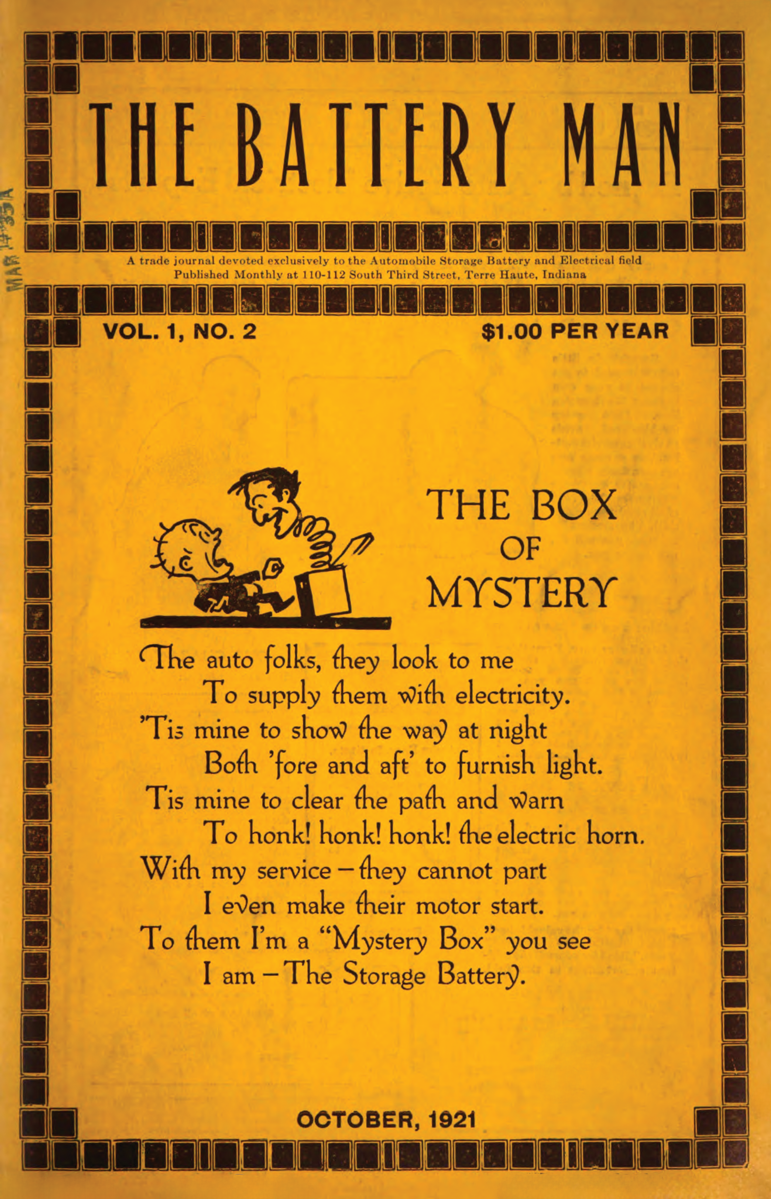
The most prevalent problem was sulfation. The discharge reaction in lead–acid batteries converts active material at both plates into lead sulfate crystals, which form a fine film over the surface of each plate. During charging, those films are converted back into active material: lead at the anode and lead dioxide at the cathode. But poor charging and storage practices can encourage larger, more stubborn crystals to form. Over time, the accumulation of hard lead sulfate crystals increases the internal resistance of a battery and can inhibit it from accepting a charge. Sulfation can gradually degrade a battery until it struggles to deliver sufficient current to start an engine.
Battery dopes, as electrolyte additives were called, were often sold as salves for sulfation. The prevalence of battery trouble, combined with the general mystery surrounding batteries, created a healthy market for those nostrums, which promised magical results. All manner of substances were advertised as being effective sulfation treatments, but the most common involved some mixture of sulfur salts: usually Epsom salt (magnesium sulfate), Glauber’s salt (sodium sulfate), or alum (aluminum sulfate).
By 1953, battery dopes were old news. The NBS began testing them in the early 1920s. It issued its first condemnation of them in 1925, a judgment it expanded six years later into a four-page document that it would send to anyone inquiring about battery additives. The bureau’s battery experts regarded dopes as the stuff of small-time fraud. When entrepreneur Jess Ritchie began selling Battery AD-X2 in the late 1940s and assays showed it to be a familiar mix of magnesium sulfate and sodium sulfate, they had little reason to regard it any differently.
But compared with the fly-by-night mountebanks who peddled battery dopes through leaflets in the 1920s and 1930s, Ritchie was persistent, well connected, and dedicated to establishing legitimacy for his product. The name AD-X2 evoked high-tech postwar feats like Chuck Yeager’s October 1947 supersonic flight in a Bell X-1 experimental plane. Ads for the additive appeared in respected trade publications, and it enjoyed endorsements from established scientists, most notably Merle Randall, whom Ritchie retained as a consultant. Randall was an emeritus chemistry professor from the University of California, Berkeley, and coauthor of a standard textbook on chemical thermodynamics.
When Ritchie became aware of the NBS’s blanket condemnation of battery additives, he rose to the fight. AD-X2, he argued, was different. Armed with Randall’s endorsement and a thick stack of customer testimonials, he took the fight to Washington, DC, where he pressed his case that his product should be exempted from the bureau’s judgment against battery additives. In an attempt to convince them of AD-X2’s merit, Ritchie and Randall corresponded with NBS scientists from 1948 to 1952. The bureau tested the product repeatedly, one time in collaboration with Ritchie, but found no effect. Ritchie’s happy customers, the NBS team reasoned, were taken in by the fact that the procedures for administering the product—cleaning the posts, topping up and stirring the electrolyte, and charging the battery slowly, among others—were themselves likely to perk up an unresponsive battery. Based on the bureau’s tests, the US Post Office Department issued a fraud order in February 1953 that prevented Ritchie’s company from conducting business through the mail.

A 1931 advertisement for the Nu-Life battery additive made extravagant claims about the product’s magical effects. (Image from The Pathfinder: Digest of World Affairs, 28 February 1931, p. 27.)
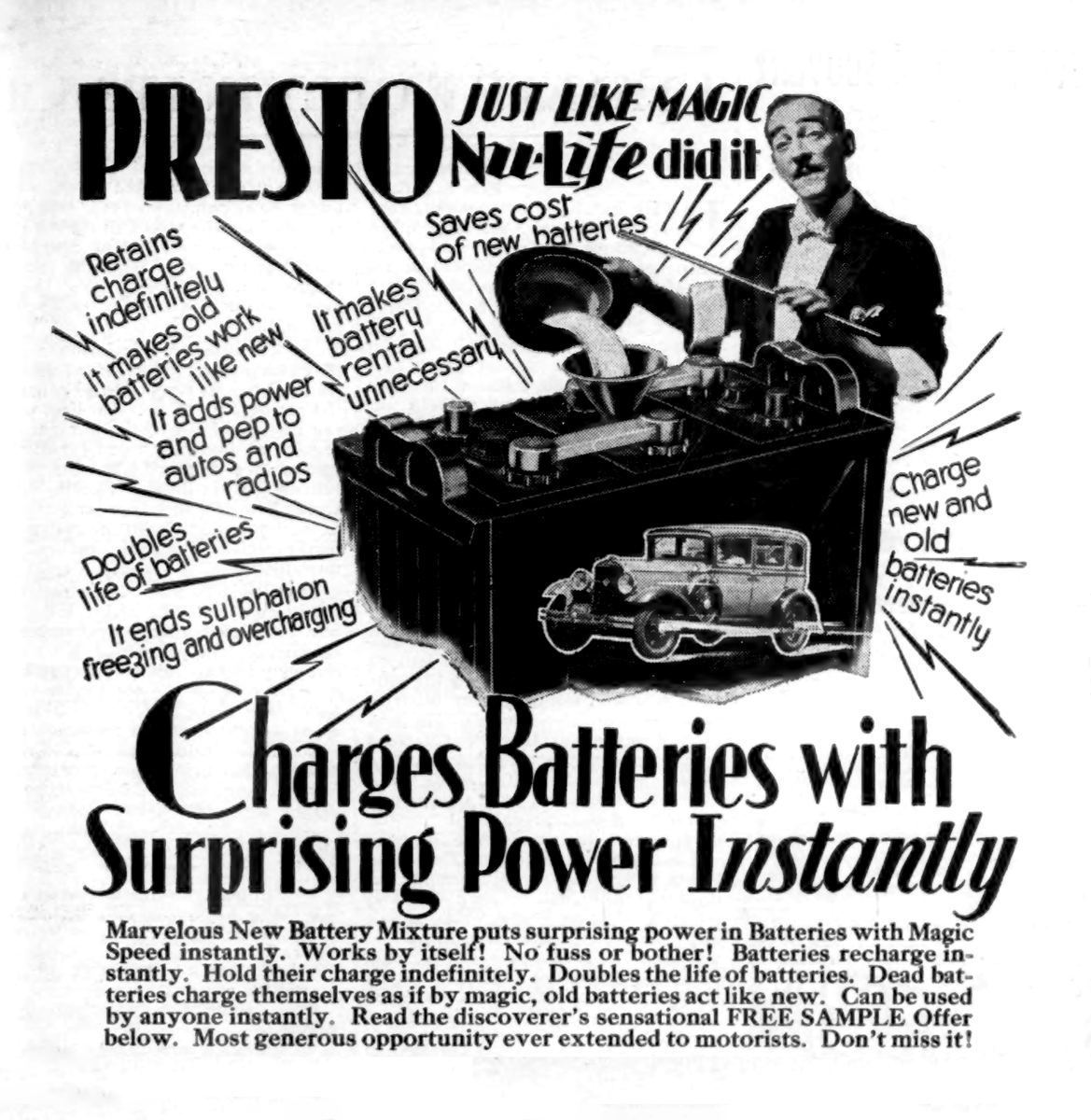
Undeterred, Ritchie pressed his case with renewed energy. He found a sympathetic ear in Weeks, whom Eisenhower had tapped for secretary of commerce shortly after winning the 1952 election. Weeks had been chairman of the board of a company that used, and liked, Ritchie’s product. In AD-X2, Weeks saw an opportunity to signal his support for small business. He successfully pressured the postmaster general into suspending the fraud order. But the controversy was far from over.
Firing and mobilization
In late March 1953, two months into the new administration, Astin was called to a meeting with one of Weeks’s assistant secretaries and asked to resign. He had yet to meet Weeks in person. Weeks justified Astin’s removal on the grounds that the bureau had “not been sufficiently objective” in handling the AD-X2 affair because it ignored “the play of the market place.” 1 More broadly, he considered it his prerogative to appoint new leaders at Department of Commerce agencies. “The Bureau of Standards is, I think, my responsibility as long as I hold the office I have,” he explained. 2
US scientists were scandalized. On 31 March 1953—the day that news of Astin’s firing broke—the president of the American Physical Society (APS), Enrico Fermi, took a phone call from F. Wheeler Loomis, one of his predecessors. Loomis had learned from the morning papers of Astin’s removal and smelled political interference. He asked Fermi to explore the possibility of an APS response, and Fermi agreed. 3
Loomis’s overture to Fermi was part of a large, spontaneous, and rapidly organized pressure campaign that sought to force Weeks to back down. Throughout April and May 1953, members of APS, the American Institute of Physics, the Federation of American Scientists, and many other scientific organizations worked zealously to coordinate a clear and forceful response with the goal of getting Astin reinstated and sending a message to Eisenhower that the independence of scientific institutions needed to be sacrosanct. Doing so required overcoming the reticence of many segments of the scientific world—particularly in the physics community—to get deeply involved in politics. As Robert Bacher, one of the members of APS’s governing committee, put the problem to Fermi, the physics community’s delicate task was to “stay out of politics but protest against injecting political or business considerations in judging scientific merits of a situation.” 4
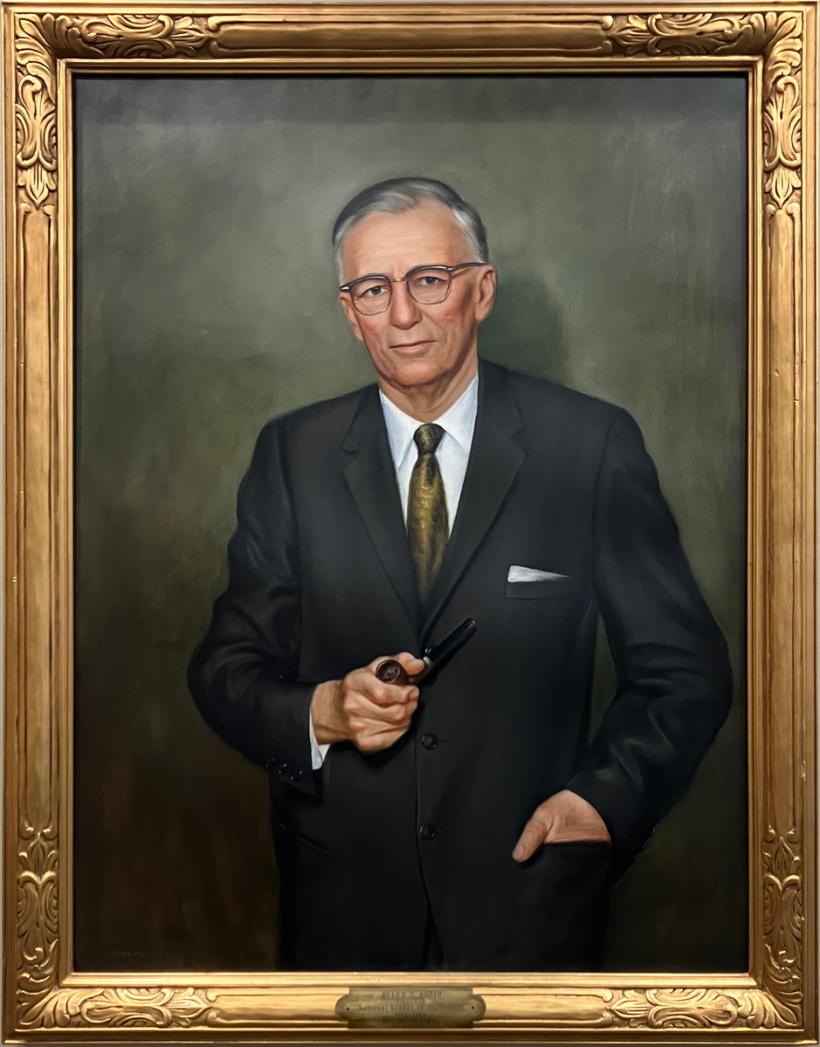
A portrait of Allen Astin on display in NIST’s hall of directors.
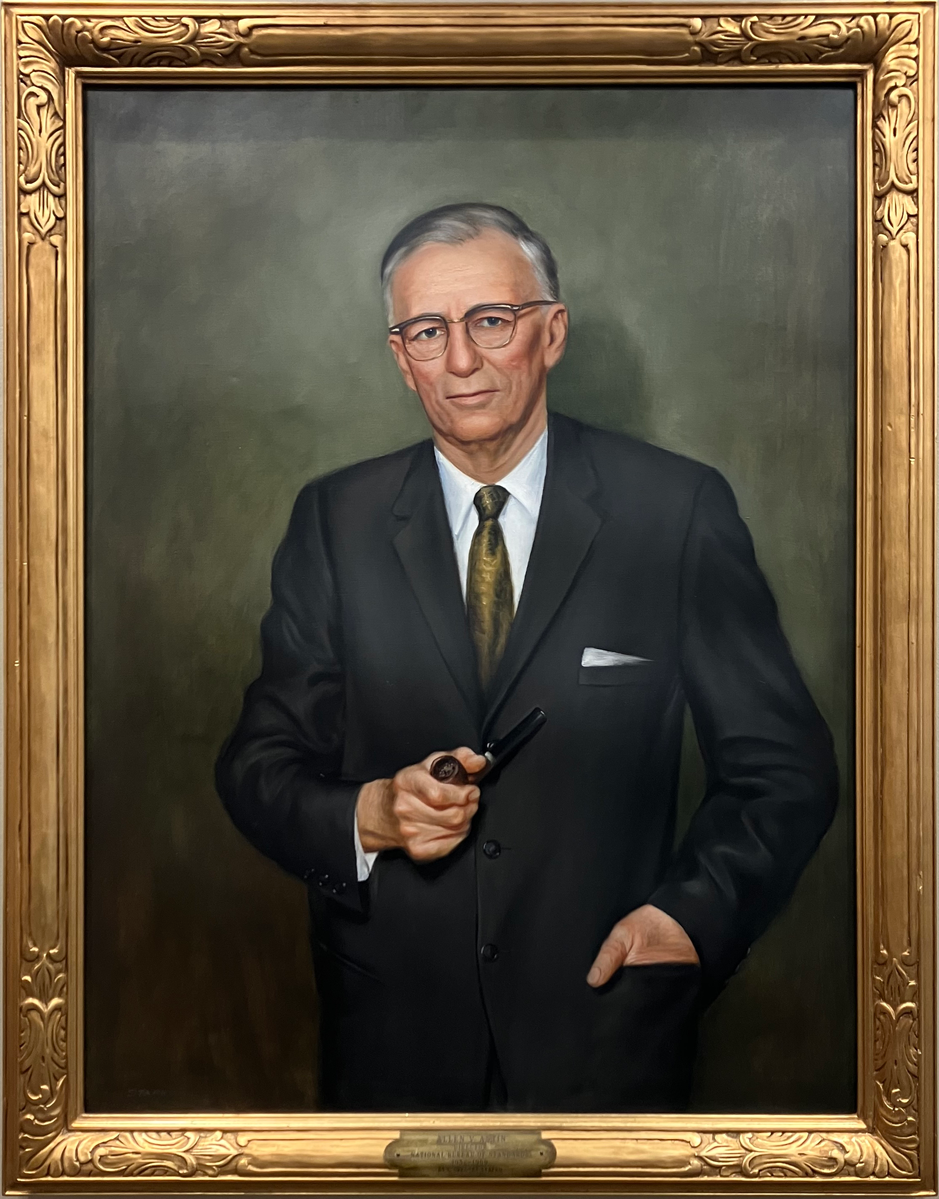
While the controversy raged, Astin spoke at an APS meeting in Washington, DC, on 1 May 1953. Referring to the controversy only obliquely, he delivered a defense of the role of impartial science in government. (The text of the talk is in the June 1953 issue of Physics Today
Astin argued that those virtues were essential for effective public service: “We believe that in order for the National Bureau of Standards to carry out its various functions and activities we must have an alert and competent staff, suitable equipment and facilities, and an environment favorable to scientific investigation and methodology. This environment or climate essentially means the provision of the opportunity to practice the beliefs I have been stating.” He needed no reference to the AD-X2 controversy for his subtext to be coruscatingly clear to an APS audience: To maintain the luxury of self-governance, US scientists would have to fight for it.
In an editorial in the June 1953 issue of Physics Today
Pressure built from multiple angles. In addition to pressure from scientific organizations, countless individuals peppered Weeks and Eisenhower with letters and telegrams. Behind the scenes, well-placed scientists implored Weeks to reconsider. Among them were members of the NBS visiting committee, the body established by Congress to oversee the bureau and report directly to the secretary of commerce. At the bureau, morale plummeted. Scores of technical staff threatened to resign on the grounds that Astin’s dismissal was an insult to their work. On 17 April, Weeks announced that he would allow Astin to remain in the post while the National Academy of Sciences surveyed the bureau’s functions and its conduct while testing AD-X2. Shortly thereafter, the Senate Select Committee on Small Business scheduled hearings on the matter. While the academy’s committees deliberated in private, the Senate hearings challenged Astin and the bureau to make their case in public.
Lab and field
Testifying before the Senate in June 1953, Astin had difficulty convincing the committee to accept the reasoning that led to his conclusions about AD-X2. The hearings aimed to determine “whether or not agencies of the Government have been fair and just in the treatment of Mr. Ritchie and his product.” 5 But government officials’ approach to scientific knowledge in the hearings favored AD-X2’s supporters. That aided Ritchie’s campaign in the political arena and made the NBS’s position more challenging.

The front and back of a box of Battery AD-X2, which includes directions for properly using the product. (Image from the National Institute of Standards and Technology Digital Collections.)
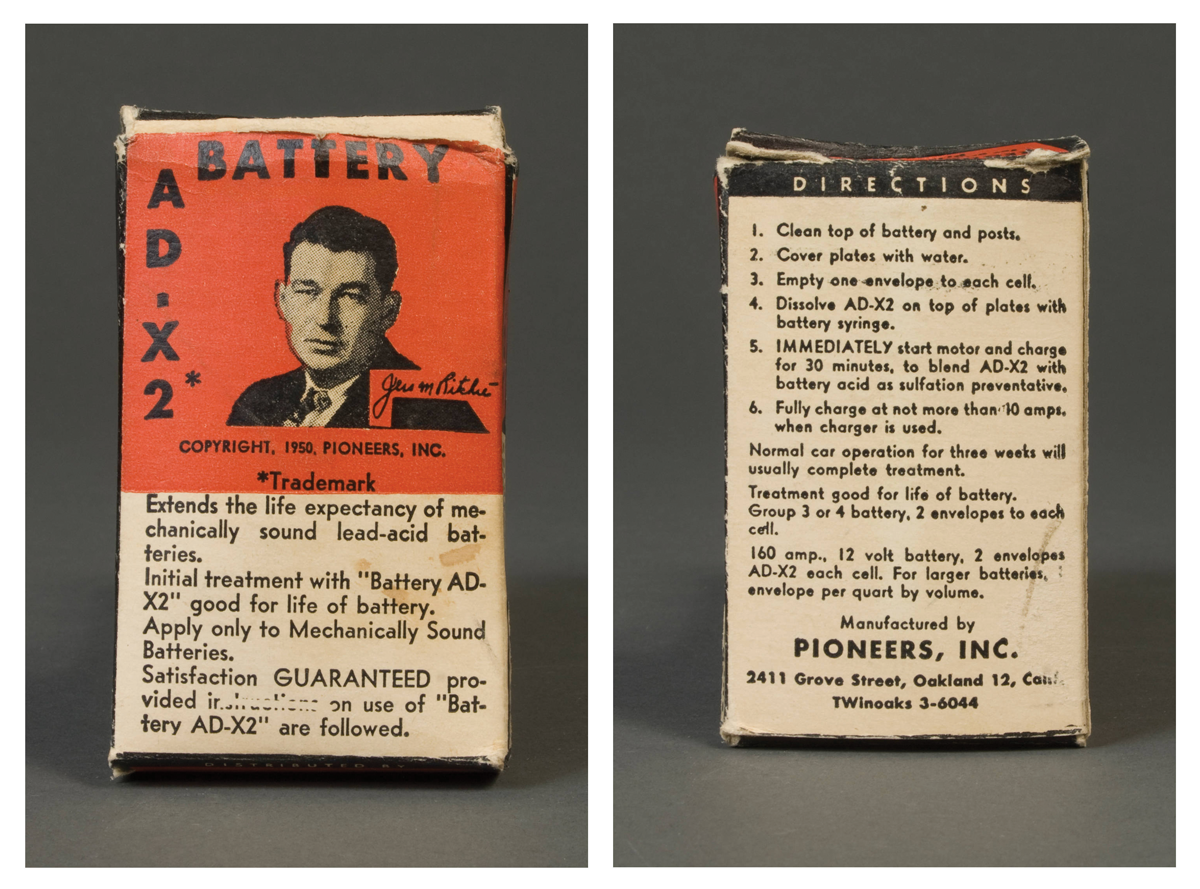
The lab–field distinction became the biggest sticking point between Astin and the committee. Astin consistently maintained that a field test would be costly, introduce greater error, and add nothing to the bureau’s understanding of AD-X2’s effects. But the Republican members of the committee remained convinced that effects invisible in the laboratory might plausibly manifest in the field. They were inclined to trust the know-how of technicians and the wisdom of the market to establish a product’s usefulness. That dynamic emerged during an early exchange between Astin and Edward Thye, the Minnesota Republican who chaired the committee:
Dr.
Astin . As nearly as I can determine, the laboratory people, that is, the engineers in the military, wherever they have made evaluations of this, have rejected it. There are some instances of shop technicians who have used the material and liked it.The
Chairman . They liked it?Dr.
Astin . And they liked it.The
Chairman . And they were shop-experienced men.Dr.
Astin . I can say that they were experienced probably in handling batteries, but I would be skeptical whether they were experienced in evaluating and interpreting data. In other words, I think that the conclusion that they drew that the material was useful might be questioned.The
Chairman . There you have again, the Bureau of Standards’ capacity for evaluating these things against the practical experience of those using the product in actual operation.6
Astin struggled to respond to that critique in a way that satisfied skeptical lawmakers. From their commonsense perspective, a definitive test could be conducted only under operating conditions—and something like that sort of test was being conducted in real time by Ritchie’s customers, especially those who managed large fleets. Astin, conscious that discerning real effects in the field was no mean feat, struggled to say so without insulting the competence of a whole class of technical workers.
Astin slept on the exchange and tried again to explain his rationale on day two of his testimony:
Many people think that the laboratory test is a sort of theoretical test and that the field test is a practical test. Now, I believe that the reverse is actually true, because in the laboratory test it is possible to make with much greater accuracy and control the measurements by which the comparisons between the two groups of samples can be compared. In the field test, additional variables are introduced; it is more difficult to make the measurements by which one will evaluate the performance of the two samples, so that from a strictly practical point of view, you can learn more about the effect of an additive in a laboratory test than you can in a field test.
7
But his reassurances appealed to public trust in the laboratory process—the very thing at issue for some committee members. Astin’s testimony illustrates that the NBS’s judgment about battery additives in general, and AD-X2 in particular, rested on laboratory tests that were followed by sophisticated statistical analysis of the type only recently adopted for interpreting laboratory work. The results were then placed into context with the long-standing battery-related expertise the bureau had been amassing almost since its inception. In Astin’s judgment, those steps collectively sanctioned the conclusion that field tests were superfluous because laboratory tests detected no statistically significant effects that a field test could be designed to look for. It also led to the uncomfortable conclusion that many presumably competent technicians had been duped.
To some senators, that reasoning and its key implication were unsatisfactory. For scientific observers, each layer of argument added additional credibility to the tests, but for skeptical laypeople, each layer offered another opportunity to quibble. Laboratory tests could be faulted for not replicating field conditions and for being conducted on a time scale well short of a battery’s lifespan. Statistical analysis methods were new, obscure, and difficult to communicate, which made them rhetorically weak. The bureau’s historical expertise could be faulted because it was based on additives other than the one in question. And hard-won practical experience could command credence at least equal to that granted to arcane laboratory procedures.
Furthermore, Thye and his fellow Republicans could not fathom that so many hardheaded businesspeople could have been hoodwinked. “The American businessman is not fooled very often—you can fool him for a little while, but you do not fool him for very long,” Thye declared. 8 The idea that thousands of US businessmen were suckers for remaining loyal to an ineffective product was perceived as an insult. “Those who have spent this money buying and rebuying can’t be all fools, Doctor,” was Thye’s refrain during Astin’s two days of testimony. Astin repeatedly declined to take the bait. 9 In fact, NBS scientists had postulated many reasons why even experienced users could be seduced into believing the product worked, but Astin would only speak to what he knew for certain.

The celebrated cartoonist Herb Block, in response to the AD-X2 affair, lampooned political reception of scientific tests in the 16 April 1953 issue of The Washington Post. (Cartoon © the Herb Block Foundation.)
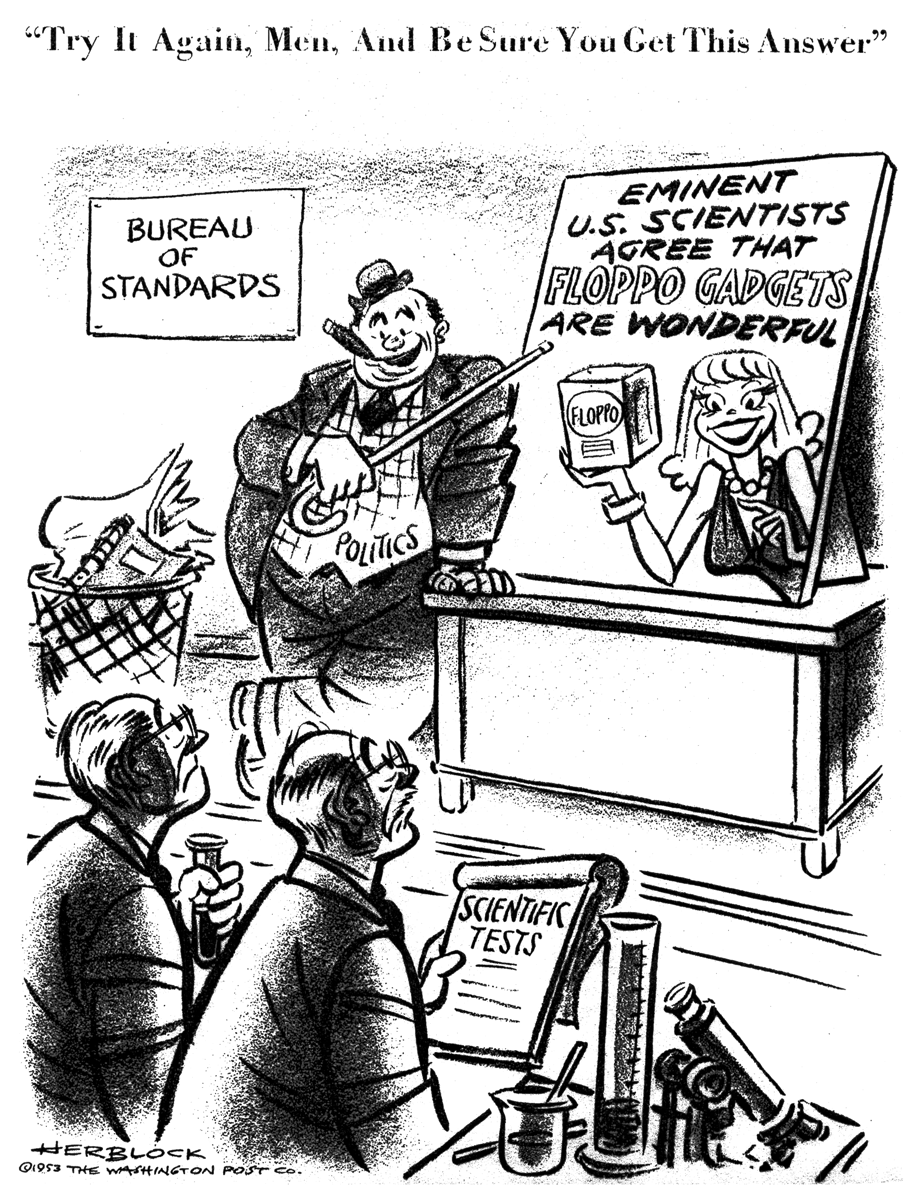
The senators arguing that Ritchie had been wronged indulged themselves in a certain amount of performative zeal for the wisdom of US businessmen, but the fundamental question of why, if the product did not work, none of its many users had seemed to notice was not itself absurd. Nor was Astin well positioned to respond. He could say only that the answer would require market research, which lay outside the bureau’s ambit. The select committee’s final report insisted that the question of AD-X2’s effectiveness remained unresolved.
For all its material and intellectual resources, the NBS could not provide a knockdown demonstration that AD-X2 was ineffective. Nor could it condemn the additive from first principles because battery science remained a largely empirical discipline. 10 Fundamental electrochemistry was a lively area of research, but by the 1950s, it had largely decoupled from the development, use, and assessment of battery technology. The bureau convinced the scientific community of its conclusions by using statistical reasoning that extrapolated from short-term laboratory tests to infer long-term behavior in the field. But that chain of reasoning was too opaque to gain traction among policymakers.
Political success
“Astin is now a symbol rather than anything else.” 11 That was how metallurgist Robert Mehl described the situation to astrophysicist Donald Menzel, his fellow NBS visiting committee member, following a trip to Washington, DC, in May 1953. At the start of the controversy, the visiting committee was not yet convinced that Astin was a good fit as NBS director and contemplated using the brouhaha to install someone the members liked better. But as the political stakes of the controversy became apparent, they, too, lined up in his defense.
Astin’s performance in the Senate hearings cemented his symbolic status, which continues today at NIST. Even though he failed to sway skeptical committee members, he projected a consistent image of a dutiful, upright civil servant who was committed to the technical work of his organization and staunchly agnostic about matters outside his expertise. In a context in which the objectivity and integrity of the bureau were called into question, the manifest personal integrity that Astin so successfully projected made him an ideal champion for the independence of scientific institutions.
Although Thye remained skeptical of the NBS’s conclusions, he was won over by Astin’s apparent decency. As he told Astin at the close of his testimony, “I could accept you as one whom I would like to have as a friend, and that is my sincere inner feeling at this time.” 12 Remarkably, even Ritchie met Astin for a warm handshake when the latter concluded his testimony. Things might well have played out differently with a different director. Edward Condon’s outspoken liberalism had seen him hounded from the NBS directorship in 1951 amid the Red Scare. 13 But Astin’s dispassionate demeanor and subdued personal politics rendered him unthreatening to lawmakers who were otherwise wary of physicists with grand political visions.
Astin’s persona was even more crucial for resolving the affair because a political victory would not be won by convincing the government of the bureau’s scientific conclusions. In October, the National Academy of Sciences released its reports, which vindicated both the bureau’s testing of AD-X2 and its conduct as a government laboratory. Weeks agreed that Astin should stay on; he would serve as NBS director until his retirement in 1969. But at about the same time, the post office announced that it could not prove that Ritchie intended to deceive customers. Citing the select committee’s view that the question of AD-X2’s efficacy remained open, it vacated the fraud order against his company. Ritchie declared that he would “pour this material in every battery in the United States.” 14

Allen Astin (left) and Jess Ritchie shake hands after the former completed two grueling days of Senate testimony in June 1953. (Image from the Associated Press.)
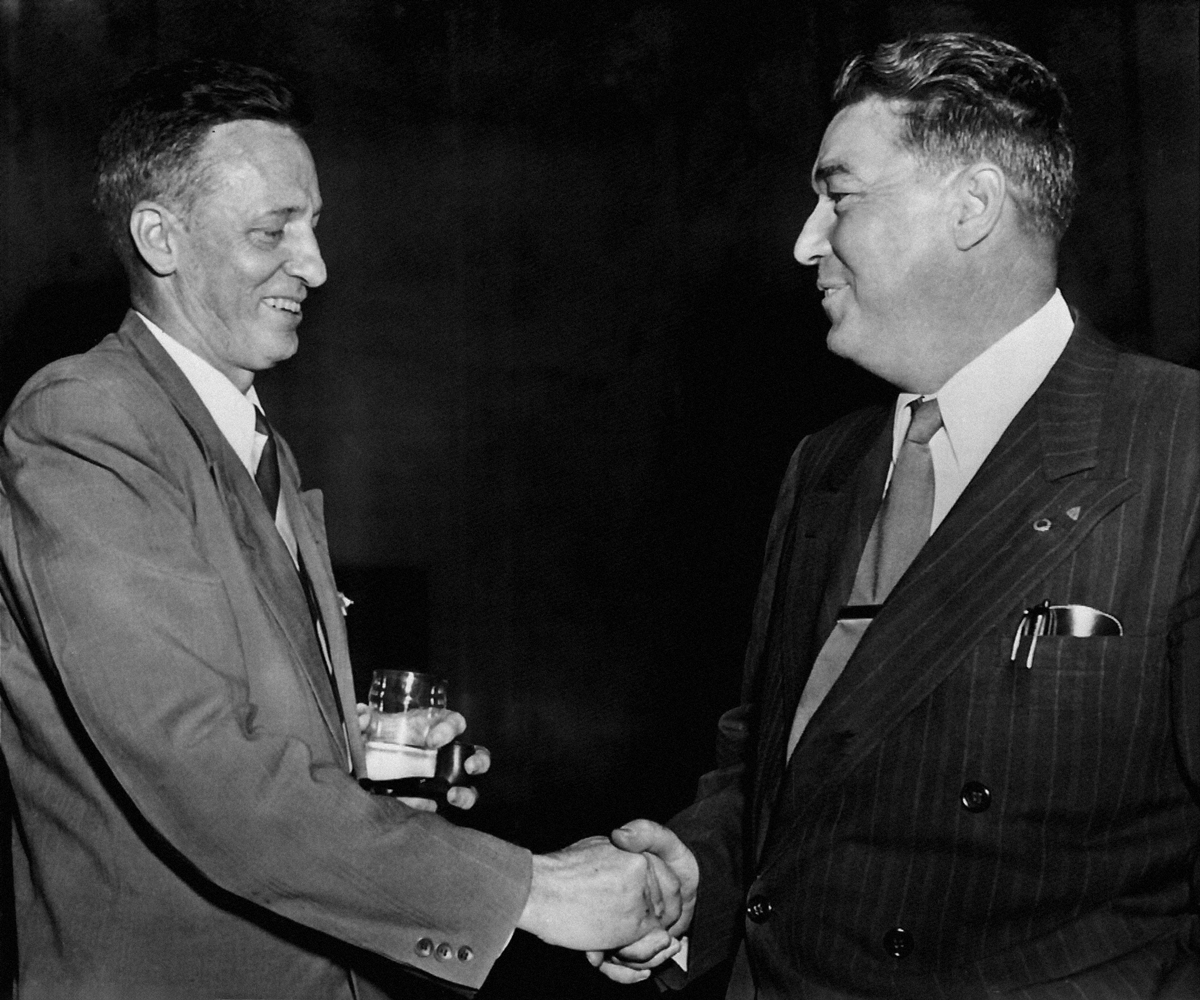
The ultimate success of Astin and the scientific community was not based on the strength of their factual claims. Theirs was a political and institutional victory. It was a consequence of their focused, coordinated, and untiring efforts to mobilize and defend scientists’ authority over scientific institutions. Scientists’ efforts to shape the politics of nuclear weapons, such as calls for international control from the likes of J. Robert Oppenheimer and Leo Szilard, had been largely rebuffed. The first Republican administration in two decades left the federal commitment to science uncertain. In that context, the fight over the NBS was a negotiation of the terms on which government science would be conducted.
As a result of that negotiation, federal scientific institutions in the US have, for the past seven decades, enjoyed a great degree of autonomy. The AD-X2 controversy did show the scientific community its limits, as well as its power, as a political bloc, and in subsequent years, the bureau and other government agencies would face further pressure to bend with the political winds. 15 But at the same time, government science remained independent enough to become an increasingly attractive career path. And federally supported research positioned itself as a powerful engine of basic research, technological development, medical advances, and economic growth.
The attack that the federal scientific system now faces is far fiercer than the one mounted by the Eisenhower administration. But the lesson to be drawn from the slant rhyme of history is that the facts alone are insufficient defense against political assault. Astin and his colleagues recognized that governments rely on scientific advice, whether or not they accept scientists’ judgment on specific issues. The work of the NBS, and NIST today, was and remains essential to the smooth functioning of the economy. Other government institutions perform similarly vital functions. That is both a reason to value their independence and a basis for mobilizing to defend it. But successfully defending institutions requires the will among scientists—who often seek to stay aloof from politics—to get political.
Many thanks to the referees for attention and insight that improved this piece, which is adapted in part from the article “Acid test: The AD-X2 affair and the political awakening of American science,” American Quarterly 77, 481 (2025).
This article was originally published online on 3 September 2025.
References
1. Battery AD-X2, hearings before the US Senate Select Committee on Small Business, 83rd Congress, 31 March and 22–26 June 1953, p. 3.
2. Ref. 1, p. 7.
3. E. Fermi, notes from telephone conversation with F. W. Loomis (31 March 1953), box 16, folder 18, Enrico Fermi Collection, Hanna Holborn Gray Special Collections Research Center, U. Chicago Library.
4. E. Fermi, notes from telephone conversation with R. Bacher (13 April 1953), box 16, folder 19, Fermi collection, in ref. 2.
5. Ref. 1, p. 9.
6. Ref. 1, p. 240.
7. Ref. 1, p. 260.
8. Ref. 1, p. 228.
9. Ref. 1, p. 334.
10. H. Chang, Sci. Context 34, 227 (2021).https://doi.org/10.1017/S0269889722000199
11. R. F. Mehl to D. H. Menzel (15 May 1953), box 7, folder 1, Papers of Donald Howard Menzel, HUG 4567, Harvard U. Archives.
12. Ref. 1, p. 335.
13. T. C. Lassman, Edward Condon’s Cooperative Vision: Science, Industry, and Innovation in Modern America, U. Pittsburgh Press (2018).
14. “Astin affair resolved,” FAS Information Bulletin, 23 August 1953, p. 1, box 16, folder 22, Fermi collection, in ref. 2.
15. C. C. M. Mody, Instrumental Community: Probe Microscopy and the Path to Nanotechnology, MIT Press (2011), chap. 2.
More about the Authors
Joseph D. Martin is an associate professor of history of science and technology at Durham University in the UK.

